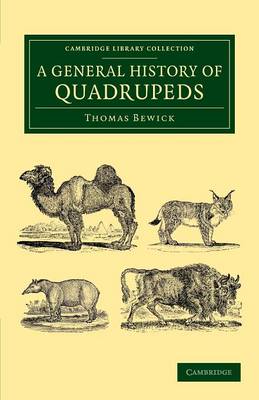Cambridge Library Collection - Zoology
4 total works
Thomas Bewick (1753–1828) began his career as an apprentice to the engraver and businessman Ralph Beilby (1743–1817). Having entered into a partnership and illustrated more than eighty small books for children, they decided to work together on this natural history, with Beilby drafting the descriptions and Bewick providing wood engravings and textual revisions. It was first published in 1790, cementing Bewick's reputation as an engraver of the natural world. Although by the end of 1797 the partnership had foundered, the book ran to seven editions and sold some 14,000 copies. Its aim was to describe and depict the domestic animals that 'so materially contribute to the strength, the wealth, and the happiness of this kingdom', and also provide entries on more exotic species, such as monkeys and big cats. Beginning with horses and cattle, this reissue of the first edition also includes an index of animals.
History of British Birds: Volume 2, Containing the History and Description of Water Birds
by Thomas Bewick
Published 5 September 2013
Thomas Bewick (1753–1828) is synonymous with finely crafted wood engravings of the natural world, and his instantly recognisable style influenced book illustration well into the nineteenth century. During his childhood in the Tyne valley, his two obsessions were art and nature. At fourteen, he was apprenticed to the engraver and businessman Ralph Beilby (1743–1817) with whom he later published A General History of Quadrupeds (also reissued in this series). The present work, with its text compiled from various sources, was the first practical field guide for the amateur ornithologist, inspiring also artists and writers. Each of the two volumes contains hundreds of illustrations of breathtaking beauty and precision: one for each species, neatly capturing its character in exquisite detail, interspersed with charming vignettes of country life. Volume 2, first published in 1804, covers water birds, including sandpipers, terns, grebes and guillemots.
History of British Birds: Volume 1, Containing the History and Description of Land Birds
by Thomas Bewick
Published 5 September 2013
Thomas Bewick (1753–1828) is synonymous with finely crafted wood engravings of the natural world, and his instantly recognisable style influenced book illustration well into the nineteenth century. During his childhood in the Tyne valley, his two obsessions were art and nature. At fourteen, he was apprenticed to the engraver and businessman Ralph Beilby (1743–1817) with whom he later published A General History of Quadrupeds (also reissued in this series). The present work, with its text compiled from various sources, was the first practical field guide for the amateur ornithologist, inspiring also artists and writers. Each of the two volumes contains hundreds of illustrations of breathtaking beauty and precision: one for each species, neatly capturing its character in exquisite detail, interspersed with charming vignettes of country life. Volume 1, first published in 1797, covers land birds, including eagles, owls, sparrows and finches.
Thomas Bewick (1753-1828) is synonymous with finely crafted wood engravings of the natural world, and his instantly recognisable style influenced book illustration well into the nineteenth century. During his childhood in the Tyne valley, his two obsessions were art and nature. At fourteen, he was apprenticed to the engraver and businessman Ralph Beilby (1743-1817) with whom he later published A General History of Quadrupeds (also reissued in this series). The present work, with its text compiled from various sources, was the first practical field guide for the amateur ornithologist, inspiring also artists and writers. Each of the two volumes contains hundreds of illustrations of breathtaking beauty and precision: one for each species, neatly capturing its character in exquisite detail, interspersed with charming vignettes of country life. Volume 1, published in 1797, covers land birds, including eagles and owls. Volume 2, published in 1804, covers water birds, including sandpipers and guillemots.

